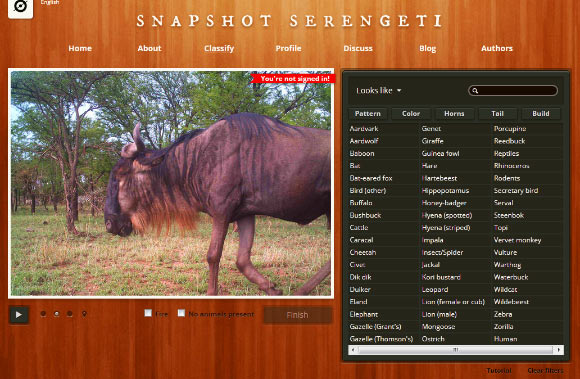More than 28,000 volunteers have helped scientists create a catalogue of more than 1.2 million camera trap images from Serengeti National Park, a UNESCO World Heritage site in Tanzania.

The Snapshot Serengeti project asked citizen scientists to review over 1.2 million camera trap images from Serengeti. Image credit: www.snapshotserengeti.org.
“This was the largest camera tracking survey conducted in science to date,” said Dr Alexandra Swanson from the University of Oxford, UK, and leader of the Snapshot Serengeti citizen science project.
Dr Swanson and her colleagues deployed 225 camera traps across 1,125 km2 in Serengeti National Park, Tanzania, to study how predators and their prey co-existed across a dynamic landscape.
The cameras have operated continuously since 2010 and had accumulated 99,241 camera-trap days and produced more than 1.2 million pictures by 2013.
Dr Swanson’s team then partnered with citizen science platform Zooniverse to design, implement, and launch the Snapshot Serengeti project.
Over 28,000 users participated, classifying images, identifying species, counting individuals and characterizing behaviors.
Of around 1.2 million collected images, 322,653 contained animals, with 40 separate species identified, including rare animals such as the aardwolf, zorilla and honey badger.
“Without volunteer help, the research wouldn’t have been possible,” Dr Swanson said.
She and her colleagues were especially impressed with the quality of the data they received.
“Every image was seen by many volunteers, and we created an algorithm to seek consensus in the identifications.”
“Computer vision research is now on the cusp of being able to recognize animals in camera trap images, but when we started Snapshot Serengeti a few years ago, there was no automated way to identify the animals in our pictures. We needed to rely on the human eye,” said team member Dr Margaret Kosmala of Harvard University.
“This project is a great example of how citizen science can contribute to real research. We all know that people are good at pattern recognition, so harnessing the power of volunteers will become increasingly important for ecology studies,” Dr Swanson said.
“We can engage people with no scientific background to help in producing publishable scientific research at a scope and scale that would otherwise have been impossible.”
A description of the Snapshot Serengeti project has been published in the journal Scientific Data.
_____
Alexandra Swanson et al. 2015. Snapshot Serengeti, high-frequency annotated camera trap images of 40 mammalian species in an African savanna. Scientific Data 2, article number: 150026; doi: 10.1038/sdata.2015.26







